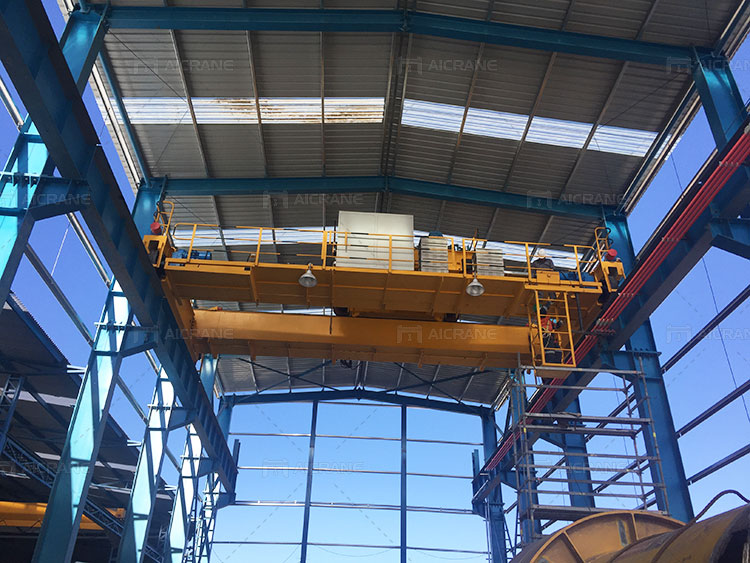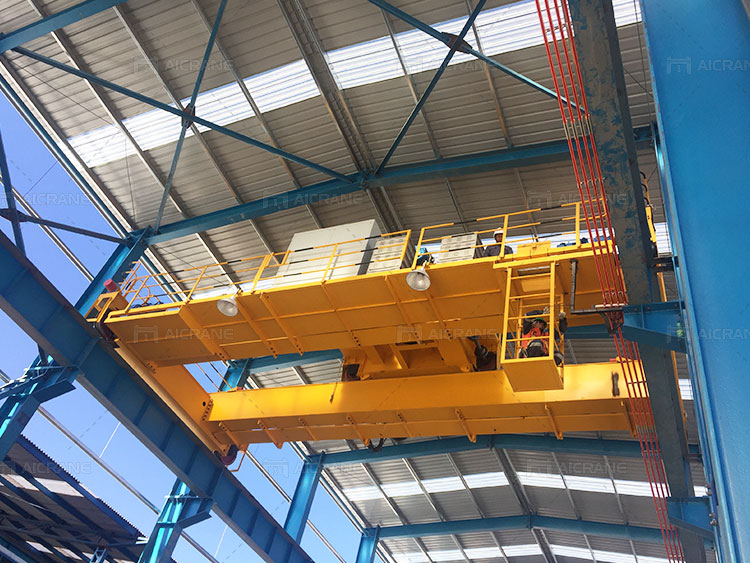Overhead cranes are critical pieces of equipment in industries requiring heavy lifting and material handling. Among the various types of overhead cranes, the 50-ton overhead crane stands out for its significant lifting capacity, enabling it to handle large and heavy loads with precision and efficiency. One key aspect that must be understood when working with these powerful machines is their duty cycle. This article will explain the concept of the duty cycle in the context of 50-ton overhead cranes, and explore various applications where these cranes are used effectively.

What is the Duty Cycle of an Overhead Crane?
The duty cycle of a 50 ton overhead crane refers to the ratio of the total time the crane operates under load, compared to the rest period when it is idle or performing light activities. It defines how frequently the crane can operate within a given period without experiencing overheating or wear due to excessive use.
In simpler terms, the duty cycle is the intensity and frequency with which a crane can operate under load, and it determines the crane’s operational limits. This factor is crucial in assessing whether a particular crane is suitable for a specific application or environment, as cranes with high duty cycles are designed to withstand more frequent, heavy operations, while those with lower duty cycles may only be suitable for intermittent lifting tasks.
For a 50-ton overhead crane, the duty cycle is generally classified by a system of duty classifications defined by standards like the ISO 4301-1 and DIN 15018. These standards categorize cranes based on the frequency of their operations and the type of loads they handle, typically ranging from light-duty to heavy-duty classifications. The duty cycle is typically expressed as a percentage, indicating the amount of time the overhead bridge crane is expected to be in use compared to its idle time.
Duty Cycle Classifications for 50-Ton Overhead Cranes
For a 50-ton overhead crane, understanding its duty cycle helps determine its suitability for specific applications. The most common duty cycle classifications for overhead bridge crane for sale include:
- Class A (Light Duty): This is for cranes that perform occasional lifting operations. They may handle light loads at low frequencies and can operate in environments where the workload is minimal.
- Class B (Medium Duty): Cranes in this class handle moderate loads and perform more frequent operations. They are ideal for manufacturing environments where cranes are used several times per day but not continuously.
- Class C (Heavy Duty): Cranes in this category are designed for heavy, continuous operations. They can handle frequent lifting of heavy loads (in the 50-ton range) and are typically used in industries such as steel manufacturing or construction, where high-frequency operations are the norm.
- Class D (Severe Duty): This classification is for cranes working in extremely harsh environments. These cranes are used for continuous, heavy-duty operations and are built for maximum endurance.
For a 50-ton overhead crane, a Class C or D duty cycle would typically be appropriate, depending on the specific industrial requirements and load demands. The crane’s ability to perform in these environments without overheating or suffering from wear and tear is critical to its long-term efficiency and safety.

Calculating the Duty Cycle
To calculate the duty cycle of a 50-ton overhead crane, the following parameters are considered:
- Load Weight: The mass of the load the crane is lifting. For a 50-ton crane, the maximum weight it can lift is 50 tons, but the duty cycle might be affected if the crane is repeatedly lifting loads close to its maximum capacity.
- Lift Frequency: This refers to the number of lifts or cycles the crane performs within a given period. Higher frequency increases the duty cycle and may require a crane with a higher-duty rating.
- Operation Time: The total time the crane spends lifting and moving loads within a specific period.
- Rest Time: The downtime the crane spends between cycles, allowing the equipment to cool down and prevent overheating.
Manufacturers and engineers use these factors to design overhead travelling crane that can meet specific industry demands, ensuring they provide optimal performance without compromising safety.
Applications of 50-Ton Overhead Cranes
50-ton overhead cranes are used across a wide range of industries, owing to their capacity to handle large loads and perform a variety of tasks efficiently. Below are some common applications:
1. Steel Mills
Steel production is one of the most demanding industries for overhead cranes. A 50-ton overhead crane is ideally suited for steel mills, where it is used to lift large steel billets, coils, and scrap metal. In these high-heat environments, overhead cranes with higher duty cycles (Class C or D) are essential to maintain operational efficiency. The crane is used to transfer materials from one part of the production line to another, ensuring smooth workflow and productivity.
2. Construction Projects
In large-scale construction projects, such as bridges, tunnels, or high-rise buildings, 50-ton overhead cranes are vital for transporting heavy steel beams, concrete panels, and other massive construction materials. These cranes are used to lift and position materials with high precision, ensuring structural integrity and safety. With their high duty cycle, these cranes are capable of working in harsh outdoor conditions and can be operated at high frequencies for extended periods.
3. Shipyards
In shipbuilding, 50-ton overhead cranes are indispensable for lifting large components such as engine parts, heavy machinery, and steel plates for ship construction. These cranes operate in environments where load handling is critical, and the duty cycle must be high enough to accommodate frequent lifts. The cranes also ensure smooth assembly of different parts of the ship, reducing delays in the manufacturing process.
4. Mining Operations
In mining, 50-ton overhead cranes are used for handling heavy equipment and materials, such as ore, tools, and mining machinery. These cranes work in environments that require a high-duty cycle, as they often need to operate continuously for long hours. The ability to handle large and heavy mining equipment makes these cranes essential in maintaining operational efficiency and productivity.
5. Power Plants
In power plants, particularly those focused on heavy energy production like coal-fired plants, 50-ton overhead cranes are employed to lift and position turbines, generators, and other critical equipment. These cranes are often used for routine maintenance or emergency repairs and are designed to handle heavy lifting tasks with minimal downtime. Their duty cycle ensures that they can handle continuous operation in high-demand scenarios.
6. Automotive Manufacturing
50-ton overhead cranes are also extensively used in the automotive manufacturing industry. These double beam overhead cranes lift and move heavy automotive parts, such as engine blocks and car frames, during various stages of the production line. Their high-duty cycle ensures that they can handle the repetitive tasks required to assemble multiple vehicles in a short amount of time.
Conclusion
The duty cycle of a 50-ton overhead crane is a critical consideration when determining its suitability for different applications. Understanding the duty cycle helps ensure that the crane performs efficiently, safely, and without causing unnecessary wear and tear on the equipment. By choosing the right duty cycle class for a particular application, industries can maximize the lifespan and effectiveness of their cranes.
Whether in steel mills, shipyards, construction sites, or power plants, 50-ton overhead cranes play an essential role in heavy lifting operations. Their ability to handle large loads and operate at high frequencies makes them invaluable in industries requiring continuous, heavy-duty material handling.
